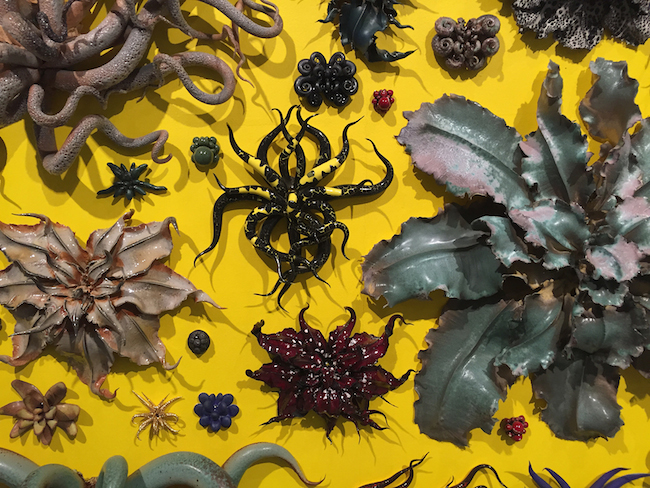The following is a piece written by Teresa Lattanzio for the Harvard Arts Blog in . Christopher Adams is a 1994 arts graduate of Harvard University and was an artist-in-residence there in 2004. His most recent exhibition Life, or Something Like It is currently on exhibition at Gallery 224 (March 23 – April 24, 2015). Images from that exhibition are included with the piece below.
Don’t be fooled by the quiet demeanor of Christopher Adams. Beneath the soft-spoken words and polite exchanges is a brilliant and vibrant artist. It takes only one look at his private studio space to recognize an astonishing imagination.


Ceramic biomorphic abstractions crawl, twist and hang from every surface, their tendrils reaching for one another and colors pulsating in conversation. Repetition and science collide to form a breathtaking jungle of art. Glaze samples are methodically laid out while unfinished sculptures sleep on wooden boards in every state from birth to bisqued. It’s a world fit for a mad scientist.
Harvard alumnus and resident artist Adams ’94 is anything but mad. What began in high school evolved into a dedicated passion for ceramics in college. Among courses on organic chemistry and evolutionary biology, Adams made time for explorations in clay at Harvard’s Ceramics Program. It was his studies that inspired his art, the romanticism of natural history prompting an explosion of nearly 3,000 sculptures during a 5-year period.


Raised near Boston, Adams went on a fateful visit to Harvard’s Museum of Comparative Zoology as a young child, immediately falling in love with the animal kingdom and all its classifications, properties and charted terrains. His playthings were labor-intensive processes: building dioramas or model replicas. His love of zoology began with miniature dinosaur toys and insect drawings.
His family eventually moved from the Boston area, settling in central Florida. When it came time for college, Adams remembered his visit to Harvard’s museum and wrote his college essay about just that. Petitioning his passion for biology, insects and art, Adams eventually made his way back to Cambridge.


As an undergrad, he explored the Ceramic Program’s satellite studio in Dunster House. Used as a gateway of sorts, he eventually found his way across the river to the main studio on the suggestion of his then instructor, Jan Bjorklund. His work there followed a slow evolution from freestanding sculptures to his current, hanging abstractions.
“Most of my ceramic works fall into the category of ‘organic abstraction,’” he says. “The pieces are influenced by, and may suggest, a variety of creatures, but none of them represent any specific organism. Instead, the works play on biological concepts – speciation, convergence, mimicry – to generate aesthetic novelty. All the works in the series are members of an arbitrarily designed family of creations unified by having the same number of appendages attached in the same order on the same basic internal framework.”


Fellow studio participants at the Harvard Ceramics Program are constantly awed by his creativity, production and simply put, time management. Despite being a practicing dermatologist, Adams is forever adding to his flora and fauna families, real and clay, and is a fixture at the studio. A slap in the face of time, he even had the audacity and generosity to construct (by hand) flowerbeds for more than 500 cacti and other succulents that now adorn the front and side entrances to the studio. Pansies contradict and overcome their cement barriers and succulents blossom in the heat of summer.
This past year Adams was a featured artist at the National Council on Education for the Ceramic Arts and is currently showing work at the Hosfelt Gallery and the Museum of Arts and Design, both in New York City. To make his show at Hosfelt a reality, Adams had to clear out his studio and ship over 700 pieces.


Christopher Adams; Life, or Something Like It, 2015 exhibition views at Gallery 224. The installation includes more than 1,500 ceramic works.
His work must drive collectors mad with desire, for his art has “strength in numbers.” He’s the sort of artist who makes you want to be better, more organized, more productive and inspired. His talent is also the sort to make you green with envy. Graduating magna cum laude from Harvard and attending medical school at Columbia is always an impressive feat, but to have the New York Times call your work “…creepily beautiful” or Home & Garden label you a “gallery star” – that is a dream in itself.
When asked how he juggles being a doctor and an emerging artist, he shrugs off the difficulties and explains that he’s most productive when pressed for time. The duality of a full-time profession with an artistic passion allows for a stable platform in which creative inspiration can have total freedom. There’s no pressure to please the masses to survive, and one can make art for art’s sake, a philosophy which drives success in its own right.

Christopher Adams
Adams is a role model for current Harvard undergraduates: You can have multiple dreams and balance academics with art. You will have to graduate and leave your classes behind, but the Harvard Ceramics Program can always be your home.
Teresa Lattanzio is a writer for the Harvard Arts Blog.

This is a brilliant exploration and I loved seeing it. Perhaps the best surprise at NCECA.
Absolutely wonderful work very very impressive that someone can do so much with one’s life yes I am green with envy I would like to have at least 100 of those creatures!